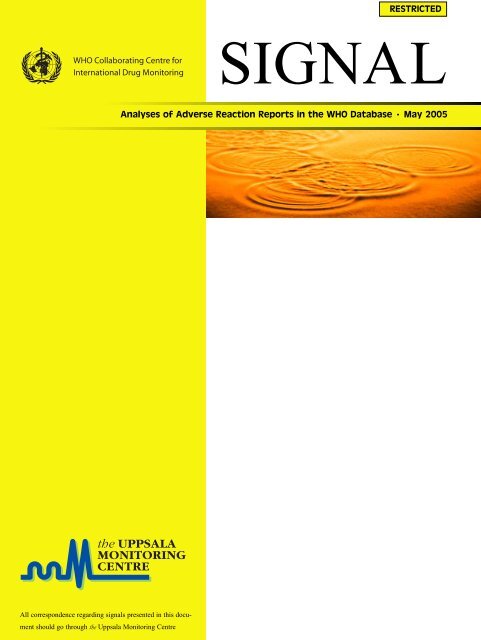Abacavir - myocardial infarction - Uppsala Monitoring Centre
Abacavir - myocardial infarction - Uppsala Monitoring Centre
Abacavir - myocardial infarction - Uppsala Monitoring Centre
You also want an ePaper? Increase the reach of your titles
YUMPU automatically turns print PDFs into web optimized ePapers that Google loves.
Signal from Dr Emilio Sanz, Spain.Table 3. Case report summaries.Time interval(months)Proteaseinhibitor therapy Dechallenge Rechallenge Outcome1 15 X Recovered3 4 U4 11 X Recovered with sequelae5 1d X X U6 23 X U7 52d U8 45d X U9 16 Died10 X X U11 X U12 12 Recovered with sequelae13 X Recovered with sequelae14 8 X Recovered with sequelae15 X U16 2d X Died17 9 X U18 X U19 19d X X Recovered with sequelae21 15 X Recovered22 23 X Not recovered23 10 Died26 X U27 11 X U28 X Not recovered29 X U30 X U31 12 X U33 X U34 9 X UU: unknownd: daysReferences:1. DRUGDEX(R) Editorial Staff 02/2004. Several references pointed out to theassociated risks of protease inhibitors and MI. In particular see: Combinationantiretroviral therapy and the risk of <strong>myocardial</strong> <strong>infarction</strong>. The Data Collection onAdverse Events of Anti-HIV Drugs (DAD) Study Group. N Engl J Med 2003;349(21):1993-2003.2. No references to cardiovascular side effects on Martindale or PDR (2004)(Micromedex).WHO SIGNAL May 20055The <strong>Uppsala</strong> <strong>Monitoring</strong> <strong>Centre</strong>
The BCPNNWhat it is, what it does and how to interpretthe numbers it generatesThe BCPNN methodologyThe BCPNN (Bayesian Confidence Propagation Neural Network) methodologyuses a neural network architecture to measure dependencies betweendrugs and adverse reactions within the WHO database. The BCPNN can beused to detect unexpected patterns in the data and to examine how such patternsvary over time. The BCPNN is using a measure of disproportionalitycalled the Information Component (IC).The Information Component (IC)The Information Component (IC), as used here, is a measure of the strengthof the quantitative dependency between a drug and an ADR. A positive ICvalue indicates that a particular drug-adr combination is reported to the databasemore often than expected from the rest of the reports in the database. AnIC value of zero means that there is no quantitative dependency while a negativeIC value indicates that the combination is occurring less frequently thanstatistcally expected in the database. The higher value of the IC, the more thecombination stands out from the background.The IC value is based on:• the total number of case reports with drug X (Cx); and• the total number of case reports with adverse reaction term Y (Cy); and• the number of reports with the specific drug-ADR combination (Cxy);and• the total number of reports in the database (C).New data may cause the IC to either increase or decrease. When the IC iscalculated from large numbers, a new report is less likely to cause a fluctuationin the IC value. The standard deviation for each IC provides a measureof the robustness of the value. The larger the Cx, Cy and Cxy values are, thenarrower the confidence interval. The IC025 is the value of the lower 95%confidence limit for the IC.Interpretation of the ICThe IC does not give any information about the qualitative causality of adrug-adr combination. The IC shows quantitative dependencies based onthe reports in the WHO database.If the IC value increases over time and the IC025 value is positive, the likelihoodof a positive quantitative association between the drug and the adversereaction is high, although clinical assessment remains essential.References:Bate A, Lindquist M, Edwards IR, Olsson S, Orre S, Lansner A, De Freitas RM.A Bayesian neural network method for adverse drug reaction signal generation. EuropeanJournal of Clinical Pharmacology 1998;54:315-321.For more information, please contact:the <strong>Uppsala</strong> <strong>Monitoring</strong> <strong>Centre</strong>Stora Torget 3753 20 <strong>Uppsala</strong>SwedenE-mail: info@who-umc.org
















